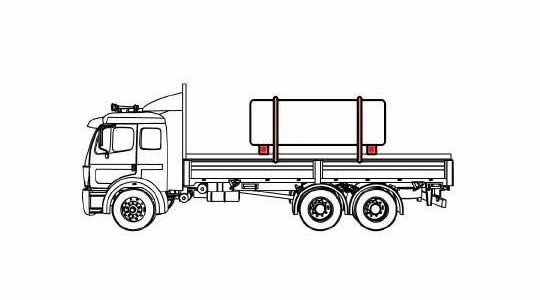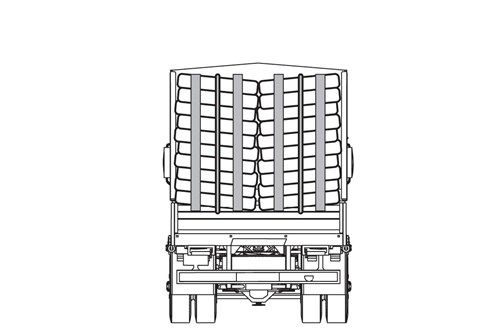CDL Practice Tests: Flatbed Cargo Securement
Choose A Section:
Go!To secure a cubic-shaped boulder, how many tiedowns are required, at minimum?
- 1
- 5
- 2
- 3
Special Circumstances: Securing a Cubic-Shaped Boulder
The securement of a cubic-shaped boulder must meet these requirements in addition to the other large boulder requirements in Section 13.

Secure each boulder individually with at least two chain tiedowns placed side-to-side across the vehicle.
Place tiedowns as closely as possible to the hardwood blocking used to support the boulder.
Requirements for securing two stacks of shortwood loaded side-by-side include:
- All of these are required.
- There is no space between the stacks of logs.
- The highest log is no more than 8 ft above the deck.
- At least one tiedown is used lengthwise across each stack.
Additional requirements securement for two stacks side-by-side
In addition to the requirements for shortwood loaded crosswise, load two stacks side-by-side so that:

- There is no space between the stacks of logs.
- The outside of each stack is raised at least 2.5 cm (1 in) within 10 cm (4 in) of the end of the logs or from the side of the vehicle.
- The highest log is no more than 2.44 m (8 ft) above the deck.
- At least one tiedown is used lengthwise across each stack.
The Aggregate Working Load Limit should, at minimum, be:
- 100% of the weight of the cargo.
- 50% of the weight of the cargo.
- 80% of the weight of the cargo.
- Determined by the shipper.
How much should the Aggregate Working Load Limit be?
The aggregate working load limit of any securement system must be at least 50% of the weight of the cargo being secured.
When securing concrete pipe with a diameter up to 45 inches loaded crosswise as a group, a crosswise tiedown should be used every how many feet?
- 6
- 10
- 15
- 3
As a group
Place lengthwise tiedowns over the group of pipes:
Either one 13 mm (1/2 in) chain or wire rope,
Or two 10 mm (3/8 in) diameter chain or wire rope
Place one crosswise tiedown for every 3.0 m (10 ft) of load length.

Either attach the side-to-side tiedown through a pipe
Or pass the tiedown over both front-to-back tiedowns between two pipes on the top tier.
In case of low friction between the cargo and deck, which of these is not a solution?
- Set the cargo on friction mats.
- Put something heavy on top of the cargo.
- Use some kind of blocking.
- Attach tiedowns to the cargo.
What should you use in low-friction situations?
When there is low friction between the cargo and the deck (for example, with snow, ice, sand, gravel, and oil):
- Use tiedowns attached to the cargo.
- Use a means to improve the friction such as friction mats or tiedown that pass over the cargo.
- Use blocking and tiedowns.
What is the minimum securement requirement for paper rolls with eyes vertical with a width between 1.25 and 1.76 its diameter?
- Tiedowns.
- All of these are required.
- Friction mats alone.
- Banding them together.
Situation #4
- A paper roll or the forwardmost roll(s) in a group of paper rolls is not prevented from tipping or falling forward by vehicle structure or other cargo.
- Paper roll width is more than 1.25 times and less than 1.76 times its diameter.
- Only friction mats are used for forward securement.
Solution #4:
The friction mat alone is adequate. The friction mat allows the roll to slide on the floor without tripping the roll.
When securing rows of coils, requirements include all of the following except:
- Attach at least one tiedown through the center of each row of coils.
- Attach at least one tiedown over the top of each coil or side-by-side row, located near the front of the coil.
- Attach at least one tiedown over the top of each coil or side-by-side row, located near the rear of the coil.
- Use blocking or friction mats to prevent forward movement.
Tiedowns

Attach at least one tiedown over the top of each coil or side-by-side row, located near the front of the coil.
Attach at least one tiedown over the top of each coil or side-by-side row, located near the rear of the coil.
Use blocking or friction mats to prevent forward movement.
As part of the log packing requirements:
- Each inside log on the side of a stack of logs must touch at least two bunks, bolsters, stakes, or standards.
- Logs must be loosely packed.
- The center of the highest log on each side or end must be above the top of each stake, bunk, or standard.
- Outer bottom logs must be in contact with and rest solidly against bunks, bolsters, stakes, or standards.
Packing requirements
- Logs must be solidly packed.
- Outer bottom logs must be in contact with and rest solidly against bunks, bolsters, stakes, or standards.
-
Each outside log on the side of a stack of logs must touch at least two bunks, bolsters, stakes, or standards. If one end of the log doesn't touch a stake:
- It must rest on other logs in a stable manner.
- It must extend beyond the stake, bunk, bolster, or standard.
- The center of the highest log on each side or end must be below the top of each stake, bunk, or standard.
Requirements for securing heavy vehicles, equipment, and machinery apply at what weight?
- More than 10,000 lbs
- Less than 10,000 lbs
- More than 4,500 lbs
- 50% the weight of the trailer
What Does This Section Cover?
The requirements in this section apply to the transportation of heavy vehicles, equipment, and machinery that:
- Operate on wheels or tracks, such as front end loaders, bulldozers, tractors, and power shovels.
- Individually weigh more than 4500 kg (10,000 lb.).
A bulkhead is defined as:
- A vertical barrier across the front of the deck of a vehicle to prevent forward movement of cargo.
- A structure, device, or another substantial article placed against or around an article to prevent horizontal movement of the article.
- A vertical barrier placed directly behind the cab of a tractor to protect the cab in the event cargo should shift forward.
- A vertical barrier across a vehicle to prevent forward movement of cargo.
Bulkhead:
A vertical barrier across a vehicle to prevent forward movement of cargo.
About The Flatbed Cargo Securement CDL Manual
Studying the flatbed cargo securement CDL manual is not a requirement for getting your CDL permit or license. It is required knowledge for flatbed drivers.
Some questions you should be able to answer for flatbed cargo securement:
- What is the minimum Working Load Limit of a tiedown used to secure logs?
- What is the minimum weight of a shipment of paper rolls that would require specific securement requirements?
- When securing concrete pipe over 45 inches loaded crosswise, which direction must the tiedowns on the front half of the load run?
- What is a cab shield?
- When securing concrete pipe over 45 inches loaded crosswise, which direction must the tiedowns on the rear half of the load run?
- What is a dunnage bag?
- Who is responsible for inspecting securing devices and cargo within the first 50 miles?
- How many tiedowns are required on a stack of shortwood loaded crosswise?
- What is the minimum working load limit of each tiedown used to secure crushed or flattened vehicles?
- Define 'bolster'
- What is a hook-lift container?
- When a tiedown is attached directly to the cargo, what is the ideal angle where it attached to the vehicle?
What is a securing device?
Any device specifically manufactured to attach or secure cargo to a vehicle or trailer:
- Synthetic Webbing
- Chain
- Wire rope
- Manila rope
- Synthetic rope
- Steel strapping
- Clamps and latches
- Blocking
- Front-end structure
- Grab hooks
- Binders
- Shackles
- Winches
- Stake pockets
- D-rings
- Webbing ratchet
- Bracing
- Friction mat
What is a tiedown?
A combination of securing devices that forms an assembly that:
- Attaches cargo to, or restrains cargo on a vehicle.
- Is attached to anchor point(s).

Some tiedowns are attached to the cargo and provide direct resistance to restrain the cargo from movement.

Some tie-downs pass over or through the cargo. They create a downward force that increases the effect of friction between the cargo and the deck. This friction restrains the cargo.
 Related Cargo Securement Terms That Every Driver Should Know:
Related Cargo Securement Terms That Every Driver Should Know:
-
Tiedown:
A combination of securing devices which form an assembly that attaches cargo to, or restrains cargo on, a vehicle or trailer, and is attached to anchor point(s).
-
Contained:
Cargo is contained if it fills a sided vehicle, and every article is in contact with or sufficiently close to a wall or other articles so that it cannot shift or tip if those other articles are also unable to shift or tip.
-
Blocking:
A structure, device, or another substantial article placed against or around an article to prevent horizontal movement of the article.
How should tiedowns be attached?
Tiedowns can be used in two ways:
-
Attached to the cargo:
- Tiedowns attached to the vehicle and attached to the cargo.
- Tiedowns attached to the vehicle, pass through or aroundan article of cargo, and then are attached to the vehicle again.
-
Pass over the cargo:
- Tiedowns attached to the vehicle, passed over the cargo, and then attached to the vehicle again.
Tiedown placement:

Place the tiedown as close as possible to the spacer.
Position the tiedowns as symetrically as possible over the length of the article.

Position the tiedowns to preserve the integrity of the article.







 TT On Facebook
TT On Facebook